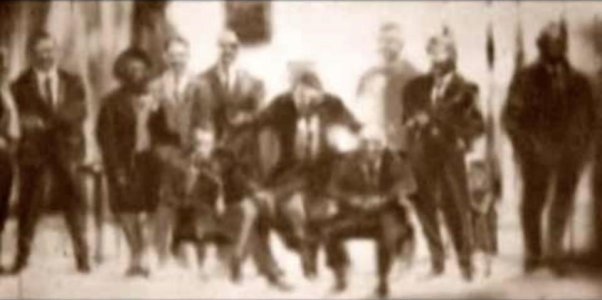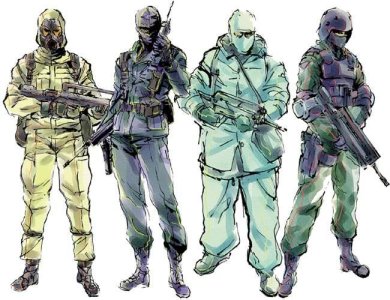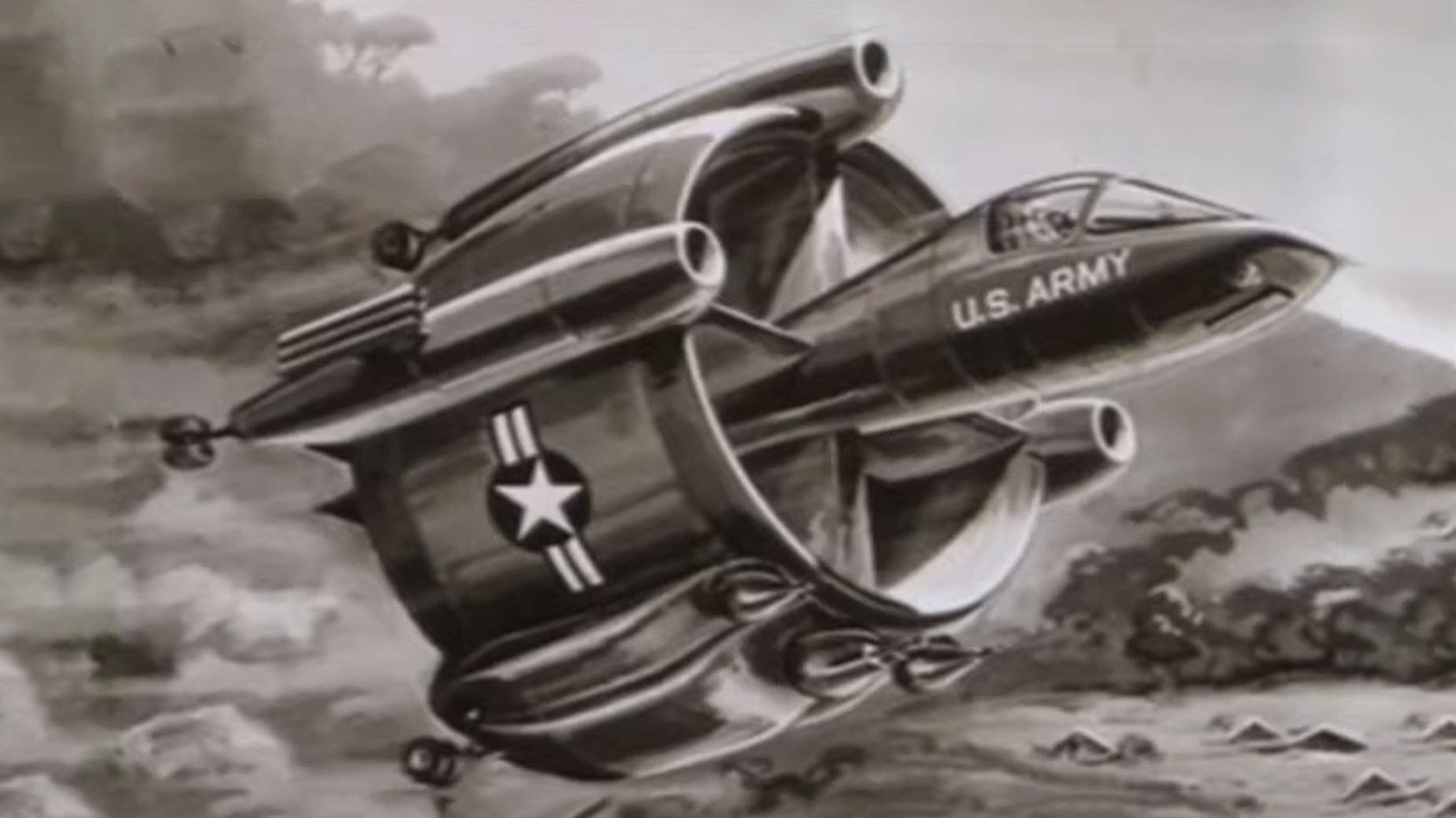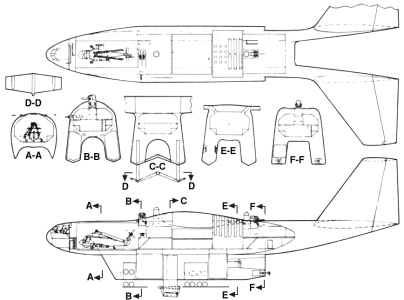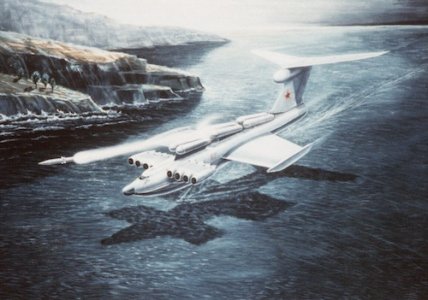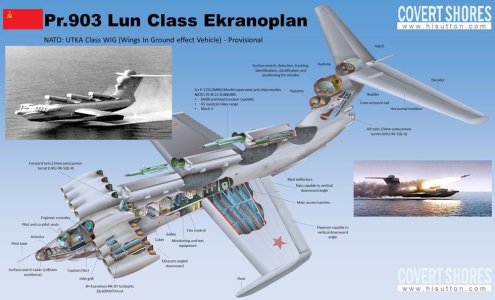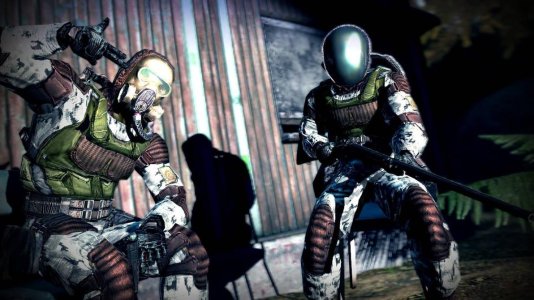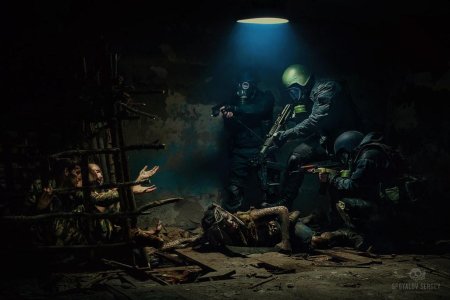Vehicle Chassis: Ender Bolt (cont.)

The United States Navy had long been experimenting with railguns for generating high muzzle velocities through electrically-accelerated conductive projectiles on its battleships, partly to counteract cruise-missile armed ground effect vessels like the Ekranoplan. Propelled into the air on twin charged rails, these rounds had the potential of traveling kilometers per second with kinetic impacts producing immense damage even without explosive warheads. But power-hungry requirements banished them to the darkness of space, deployed on the American Archimedes Array’s anti-ballistic solar satellites.
Railguns returned to Earth in an environment nearly as frigid. Cape Prophet’s Shroud, on formerly depopulated Chirikof Island of Alaska, became the site of a subterranean naval research station devoted to further experimentation with railgun (and more speculative coilgun) weaponry. Separated from the rest of the remote island by a glacial expanse, the cape was completely isolated from all trespassers, or so ONI thought.
 Breaching the perimeter of Naval Weapons Station Prophet’s Shroud
Breaching the perimeter of Naval Weapons Station Prophet’s Shroud
One moonless Halloween, the railgun test facility was captured by an armed band. After slaughtering the DEVGRU garrison, the terrorists’ leader identified themselves as patriots of the Revolutionary Republic of Kenai and Kodiak, one of many short-lived secessionist movements that had sprouted in the Hypersurvivalist Wars. General Hummer demanded that the U.S. recognize the RROKK, reinstate its government-in-exile, and immediately redirect all reconstruction funding from the tyrannical regime in Juneau to the sovereign state as foreign aid. If refused, they would have no resort but to seize the expensive toys the Navy had built while the children of Soldotna starved, selling all to the highest bidder.
Coast Guard Base Kodiak scrambled a Maritime Security Response Team to Chirikof Island. Mysteriously, they too were wiped out by what should have been no more than a rabble of survivalist holdovers. Its hand forced again, the Pentagon released the lone soldier-agent they had incarcerated after the Elysian Galzburg Event for yet another infiltration and weapons scientist rescue mission. And so he sneaked, discovering that the RROKK secessionists were not Holnist historical reenactors but, to a man, had abilities on par with any operator of the commands under SOCOM or the homeland services. Their armaments were not battlefield salvage from the Pax Decay wars but cutting-edge, including resonance edges and free electron carbines. Furthermore, the rebels were augmented with Soviet advisors- namely
spetsnaz- who provided extra muscle for the operation.
Mattias Nilsson's combat aptitude won him entrance into the Swedish Coastal Artillery of the Unified Norden Navy at a young age, and his chaotic belligerence lost him the honor of being an Arctic Ranger after a career of suicidal daring. A destructive stint in the Brödraskapet Wolfpack
(“Wolfpack Brotherhood”) motorcycle gang later, he was arrested before escaping the Unified Norden Realm, becoming an international- then interstellar- soldier of fortune
As the endless night dragged on, intruders entered the fray. While a Japanese cruiser, the JS
Atsushi, sat in international waters and surveyed the situation, a midget submarine launched from the mothership. It delivered a JMSSDF Special Boarding Unit team to the underground docks beneath the base. Meanwhile, mountain operations troops from the Royal Canadian Army Advanced Warfare Centre performed a HAHO jump (high altitude high open) in the skies above. Landing atop a glacier, alpine warfare soldiers climbed down to the station. Both squads confronted the secessionists and their allies at Prophet’s Shroud.
The American-sent operative crept past the crossfire before an explosion rocked the cape. Ex-Arctic Ranger Mattias Nilsson made his entrance, shooting at terrorist and counter-terrorist forces alike with no regard to stealth. The one-man Norden army rampaged through the base, but his lack of subtlety allowed the lone operative to ambush and interrogate him. Unlike many others, Nilsson spoke not in riddles. He chased rumors of more than mere counter-ICBM satellite weaponry. Deep below, according to intel, the American military was building no less than an Ender Bolt. All were in a race to steal its secrets, and to secure it for their own cause.
The Kargil Strike, live-fire demonstration of the Ender Bolt LEO
Disbelieving, the operative left the mercenary demolitions expert tied up and tranquilized in a locker and descended into the depths of the base. With every new battle, reality slowly dawned. He discovered stockpiled nuclear material and a vast chamber that had been used for covert underground tests. He found schematics for a stealth re-entry vehicle designed for precision fire. A rescued weapons scientist revealed that the United States had indeed restarted the Ender Bolt project. Leveraging next-generation technology, the new shagokhod was nearly fifty feet tall, equipped with two railguns that could launch nuclear payloads without chemical propellants. Not only would this be undetectable by rocket emissions-tracking ballistic detection systems, it abrogated no treaty- projectiles fired in this manner did not even
qualify as missiles! All it required was a surface-piercing warhead to penetrate hardened underground bases. With this machine, the U.S. would be king of the nuclear jungle. They called it LEO.
The hunt was on for the launch codes of the Ender Bolt. As the soldier-agent fought towards the hangar, the spiders’ webs materialized under the rising sun. The Russians were members of
Novaya Svoboda, “New Freedom,” a breakaway faction of the Soviet Army. Also committed to ending MAD, these hardliners sought to launch an act of nuclear terrorism on American soil, provoking a world war terminus which they believed communism would win. They assisted the RROKK secessionists, promising to spare the Kenai Peninsula and Kodiak Island in exchange for a time-share of the nuclear launcher. Arriving at the central silo, the operative realized he was too late. Ender Bolt LEO was fully operational. It raised a giant railgun into the dark sky, and fired.
Contrary to their threats, the secessionists did not launch their opening salvo at Edge Knot City in the western United States. The target was Kargil district, the heavily radiation-poisoned, desolate ground zero of the Six-Minute War. Instead of forcing the superpowers into a deathmatch, he paid homage to where two great powers had ended each other decades earlier. This was to be a warning shot, proof that their weapon was functional and that their will was steel. The Revolutionary Republicans then turned their guns on the Russian patriots.
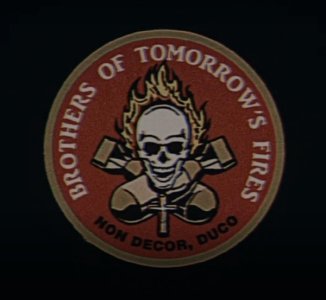 Unit patch of the RROKK secessionists. Latin motto is “I am not led, I lead”
Unit patch of the RROKK secessionists. Latin motto is “I am not led, I lead”
They declared that their original demands were no lie, that it was all for freedom. General Hummer revealed that they were not the former hypersurvivalists who had made war against the federal government, but were once counterinsurgency special forces genetically enhanced and cybernetically upgraded to combat the same. Originally earmarked for foreign adventures against People’s African Union decolonizers in the Great Lakes War and Red Cuban holdouts in the Caribbean, they were brought home to fight their fellow Americans. Whether Kellerite, Holnist, Never-Treader, or just plain neutral, all became targets to eliminate under their sword. In the end, brother-on-brother bloodshed was too much, even for them. Forsaking their mandate to uphold misery, in Alaska the enhanced rejected their mission, joining the very people they once fought. In return, the federal government engaged a killswitch. Process Balnibarbi Sphereland halted the supply of immuno-suppressants, causing the enhanced grievous side effects from experimental treatments.
But now they could demand vital medication from the government- lest their dirty deeds be made public- and guarantee a homeland for all sick of fighting under false flags. The U.S. needed only to grant them liberty and life, and it would never have to fear their Ender Bolt.
It was not to be. The operative wavered only slightly as he completed his mission. After a difficult duel involving CQC, Hummer was slain by his hand. As the RROKK fell to in-fighting with the Russians, the surviving DEVGRU Navy SEALs took the chance to exact revenge upon the Spetsnaz GRU who had killed their comrades. The remaining foreign fighters helped the operative mop up the secessionists. As the final fight waged, an explosion once again roared through the silo. Ender Bolt LEO, already greatly damaged, was ripped apart by the blast. Out of the smoke stepped Mattias Nilsson, detonator in tow. Revealing himself to be on contract with the IAEA, the Swedish mercenary told the operative that
his mission was accomplished, and disappeared on a hijacked Canadian ground earth machine.
Following security breaches, the Department of Energy was made guardian of all U.S. atomic hod projects, specifically its Full-Spectrum Protective Force, known as “closers” (as in closing Pandora’s Box)
Following the Night of Prophet’s Shroud, the legend of the Ender Bolt permeated across the globe. Despite destruction of both the prototype and the initial version, the idea of a fully-mobile, self-sustaining, treaty-compliant railgun-armed shagokhod capable of delivering an untraceable nuke became a dream to both nation-states and non-governmental entities alike. As blueprints of the LEO and its stealth warhead were somehow leaked onto the black market, governments, gigacorps, and gun-shakers began constructing their own variants. Less than five years after the events under Chirikof Island, the junta in Bolivia won the race to build a successor super-hod, albeit without a working nuclear device. As many critics feared, the coming of the Ender Bolt promised to irrevocably disrupt the nuclear balance, weakening previous counter-measures and treaties. As anger grew at the United States for letting the Kargil Strike happen under its watch, the possibility of further agreements diminished, and as of the UNS
Unity launch in 2071 there was still no sign of an END III.
Not long after, a second was rumored to be kept in an Imperial Military Focus facility hosted by Mthwakazi-Mutapa, stolen from a joint Anglo-French project by Brigadier Heid’s ruthless private operators. Nwabudike Morgan, returning to his origins as an arms dealer, formed Morgan Tactical Special Action Reconnaissance Services from the cream of his industrial espionage crop and sent them into El Gauad to secure the prize for himself. Instead, his agents discovered a half-finished shell that IMF squaddies were using for target practice, its railgun and useful components already stripped. The Mogul wrote off the venture as a successful product demo, marketing Morgan T.S.A.R.S. as “Purveyors of the best intel your money can buy.” So useful were the T.S.A.R.S. units, he would one day recreate the organization on Chiron as the probe department of the Centauri Monopoly.
 Khalkotauroi artillery gani of the Digital Oracle was the precursor chassis to the faction’s very own Ender Bolt. Due to Planet’s greater gravitational field, the stability of multi-legged ganis were favored over bipedal hods for firing high-powered weaponry
Khalkotauroi artillery gani of the Digital Oracle was the precursor chassis to the faction’s very own Ender Bolt. Due to Planet’s greater gravitational field, the stability of multi-legged ganis were favored over bipedal hods for firing high-powered weaponry
The
Unity diaspora reinvented Ender Bolts only after the realization of Greater Gauss Guns and the mainstreaming of Chironian hods. But those were only two members of the triad that defined the war machine. The third, nuclear weapons, was fairly scarce on Planet. Between the Muntz Report limiting the mission’s stockpile and the abundance in thorium leading to widespread use of breeder reactors that produced low-weaponization potential uranium-233, there were fewer sources for reliable fissile material. The U.N. Charter forbade the use of the a-bomb as a weapon of mass destruction, and while some factions attempted to develop their own atomic arsenals, it was not particularly popular as offensive weaponry. Regardless, the mighty mechanical platforms were still prized for their ability to deliver swift strikes with minimal thermal signature, essentially mobile mass drivers. As with the LEO and its offspring on Earth, these pseudo-Ender Bolts were far more armored and armed than conventional hods or gani, able to go toe-to-toe with a highship or even landship.
The Coeus
, the first Ender Bolt constructed on Planet, and perhaps the only built by humanity in at least three centuries
Only with the advent of the planet buster did the Ender Bolt fully regain its fearsome reputation. These nightmarish quasi-nuclear plasma explosives, each with the starting blast yield of nearly three hundred gigaton of TNT (over sixty times that of the Tsar Bomba), truly brought back the prospect of MAD that haunted latter-day Earth. As factions began planet buster crash programs, so did the arms race to build the best method to house and deliver doomsday.
Once again, Ender Bolts became the most fearsome herald of particle obliteration. The completion of such a Secret Project was a momentous event, and factions were often unable to resist announcing their new wonder weapon to the world. As many were sheathed in the most advanced defenses known to science, they were even rumored to be indestructible by planet busters. At the very least, discovering- and then destroying- a modern Ender Bolt through conventional means required dedicated military resources. And so, like on Earth, these war machines became the focus of tactical espionage action. Massive shadow vendettas waged as factions shifted to covert means to disable, dismantle, or deprive rivals’ Ender Bolts. This siphoned off open conflict, making these doomsday devices the province of probe teams, just as it served as an outer heaven for deniable mercenaries, terrorist groups, and rogue special forces during the Cold War. Ironically, in the age of the planet buster, Ender Bolts finally lived up to their name, enforcing deterrence.
Design Notes
Funnily enough, the final picture I used is of a mech unit from the design workshop of
Pandora: First Contact, and one of the original inspirations for this concept to begin with.
In my initial notes, I simply wrote that an Ender Bolt was built in Alaska, and another by the Bolivian junta. This ended up being a full loose adaptation of the original
Metal Gear Solid with generous references to other materials. Memetic mutations- I imagined the terrorists to have been Alaskan separatists of some sort, so I borrowed their name via the
Temporary Republic of Kenai and Kodiak from
Snow Crash. As in that novel, I had these all-American rebels unexpectedly aided by Soviet Russian fanatics, though of a different sort- the off-screen nuclear terrorists from
A Beautiful Mind rather than Russian Pentacostal “Orthos.” I also made the twist be that they were former American special forces, with the RROKK becoming an unplanned pun- unpunned?- for
The Rock, which was most likely one of Kojima’s many action film influences for his game. And them being augmented super-soldiers? Both a
Metal Gear trope and ties this all back to
The Postman by David Brin with a nod to the Holnists, who are already present in the RtD setting.
The technical specifics and justification of the rail-gun launched stealth nuclear weapon are from
Metal Gear Solid code conversations with Otacon, namely
The perfect nuke,
REX's rail gun
Additional real-world analysis of the titular machines provided by thread
So ... how USEFUL would a Metal Gear be in real life?
Notes
Chirikof Island is a real-world location, the site of a probably mythical tsarist Russian penal colony,
two thousand feral cattle, and
placed on the list of potential nuclear weapons test sites in the 1960s under Project Rufus and Project Larkspur. I found it simply by scrolling around Alaska on Google Maps until I saw a suitably remote island and had no idea of its strangely resonant history. Though I suppose it’s natural for its remoteness to have led to it being considered for such atomic testing schemes. Cape Prophet’s Shroud is an obvious reference to
Shadow Moses Island.
Mattias Nilsson, voiced by Peter Stormare, is a
playable protagonist, perhaps the most present in the marketing materials, of
Mercenaries: Playground of Destruction and
Mercenaries 2: World in Flames. (
Biography according to sequel)
New Freedom is from
A Beautiful Mind - full ideology described in the
film’s script on page 36.
Edge Knot City is a
fictional location from
Death Stranding.
Kargil in Kashmir was chosen for its real-world site of the
Kargil War, an Indo-Pakistani conflict in 1998 that sparked fears of a regional nuclear war.
“El Gauad” is an anagram for
Galuade from
Metal Gear: Ghost Babel.
Gani, がに, is Japanese for crab.
Image Credits
Space-based defense railgun is
Department of Defense art, 1984.
Orbital railgun schematic shared from
Aerospace Projects Review Blog by Scott Lowther
Assault on snow base is from
Spriggan (1998)
Animated mech gif is taken from “
Obscure Metal Gears: Metal Gear GANDER” by Pliskin, from
Metal Gear: Ghost Babel
Brothers of Tomorrow’s Fires insignia is from
The Righteous Gemstones
Department of Engineering combat squad is the
Protection Technology Inc. Special Response Team, posted to Los Alamos Labs
Walking mobile artillery cannons are the
Multipodal Battery from
GODZILLA: Planet of the Monsters
Blue four-legged mech is a rails-armed Titan mech unit from
Pandora: First Contact


